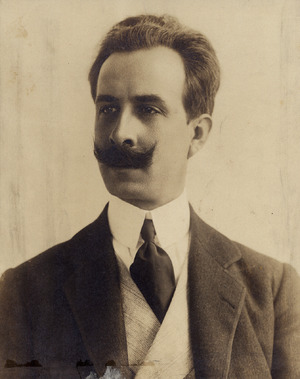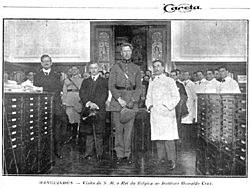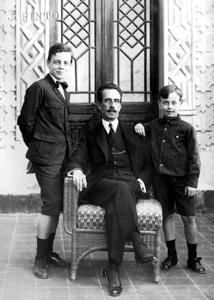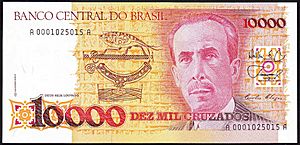Carlos Chagas facts for kids
Quick facts for kids
Carlos Ribeiro Justiniano Chagas
|
|
|---|---|
 |
|
| Born | July 9, 1879 Oliveira, Minas Gerais, Empire of Brazil
|
| Died | November 8, 1934 (aged 55) |
| Alma mater | Medical School of Rio de Janeiro |
| Known for | Chagas disease |
| Parents |
|
| Awards |
|
| Scientific career | |
| Fields | Physician Medicine |
| Institutions | Instituto Oswaldo Cruz |
Carlos Justiniano Ribeiro Chagas, often called Carlos Chagas, was a famous Brazilian doctor and scientist. He was born on July 9, 1879, and passed away on November 8, 1934.
Carlos Chagas made a huge discovery in 1909. He found a new disease called Chagas disease, also known as American trypanosomiasis. He did this while working at the Oswaldo Cruz Institute in Rio de Janeiro.
His work is very special in the history of medicine. Even though he worked in tough conditions, Chagas fully described this new infectious disease. He identified what caused it (the pathogen), how it spread (the vector insect), and how it affected people. He also showed how the disease moved through a population. Chagas was also the first to find a type of fungus called Pneumocystis. This fungus later became known for causing a serious lung infection in people with weak immune systems.
Early Life and Education
Carlos Chagas was the son of José Justiniano das Chagas, a coffee farmer, and Mariana Cândida Chagas. Both of his parents were from Portugal. He went to school in Itu and São João del Rei.
He first started studying mining engineering. But in 1897, he changed his mind and joined the Medical School of Rio de Janeiro. His uncle, who was a doctor and owned a hospital, influenced him. Chagas finished medical school in 1902. The next year, he earned his M.D. with a paper about how malaria affects blood. He worked at a new medical research center started by his friend, Oswaldo Cruz.
After working as a doctor in the countryside for a short time, Chagas took a job in the port city of Santos. His task was to fight a malaria outbreak that was making workers sick. He came up with a new idea: using pyrethrum, an insecticide, to spray homes. This worked surprisingly well! His work on this method helped prevent malaria around the world. The Brazilian Ministry of Health even adopted his method.
Discovering Chagas Disease


In 1906, Chagas returned to Rio de Janeiro and joined the Oswaldo Cruz Institute. He worked there for the rest of his life. In 1909, the institute sent him to a small town called Lassance. He was there to help with a malaria outbreak among workers building a new railroad.
He stayed there for two years. Soon, he noticed that rural houses were full of a large, blood-sucking insect. This insect was a type of "assassin bug" or "kissing bug" (called barbeiro in Portuguese). It got this name because it bit people's faces at night to drink blood.
Chagas found tiny protozoans, a type of parasite, in the intestines of these bugs. He proved that these parasites could spread to marmoset monkeys if the infected bugs bit them. Chagas named this new parasite Trypanosoma cruzi, honoring Oswaldo Cruz.
Chagas thought this parasite might cause human disease. This was because the bugs lived in people's homes and bit them. So, he took blood samples from people. On April 23, 1909, he found the same Trypanosoma parasite in the blood of a 3-year-old girl. He also saw signs of the parasite in the brain and heart of sick people. This helped explain some of their symptoms. He also suggested that armadillos might carry the parasite naturally.
To finish his research, Chagas described 27 cases of the early stage of the disease. He also studied over 100 people who had died from the long-term form of the disease.
His detailed description of this new disease became famous in medicine. It brought him recognition both in Brazil and around the world. He was chosen to join the National Academy of Medicine. On June 22, 1912, he received the important Schaudinn Prize. This award was for the best work in studying protozoa and tropical diseases. Many other famous scientists who later won the Nobel Prize for Medicine were also considered for this award.
Chagas also convinced an Argentine doctor, Salvador Mazza, to study the disease. Mazza confirmed that Trypanosoma cruzi existed in Argentina in 1927. This led to government action to fight the disease there.
Chagas was also the first to find the fungus Pneumocystis in the lungs of animals infected with trypanosomes. At first, he thought it was part of the parasite's life cycle. But his discovery led other scientists to study it more. They found that Pneumocystis was a separate type of fungus. Chagas quickly agreed with this new finding. Pneumocystis is now known to cause a lung infection called pneumocystis pneumonia.
Later Life and Legacy
After Oswaldo Cruz passed away in 1917, Chagas became the director of the institute. He held this important job until he died in 1934. From 1920 to 1924, he also served as the director of the Department of Health in Brazil.
He started a nursing school. He also helped create the idea of sanitary medicine, which focuses on public health. He was the first professor of tropical medicine and hygiene.
Carlos Chagas died in Rio de Janeiro in 1934 from a heart attack. He was 55 years old.
One of his sons, Carlos Chagas Filho (1910–2000), became a very respected scientist. He worked in the field of neurophysiology and led the Pontifical Academy of Sciences. Another son, Evandro Chagas (1905–1940), was also a doctor and researcher in tropical medicine. He died in a plane crash when he was 35. A major biomedical research center, the Instituto Evandro Chagas, is named after him.
See also
 In Spanish: Carlos Chagas para niños
In Spanish: Carlos Chagas para niños




